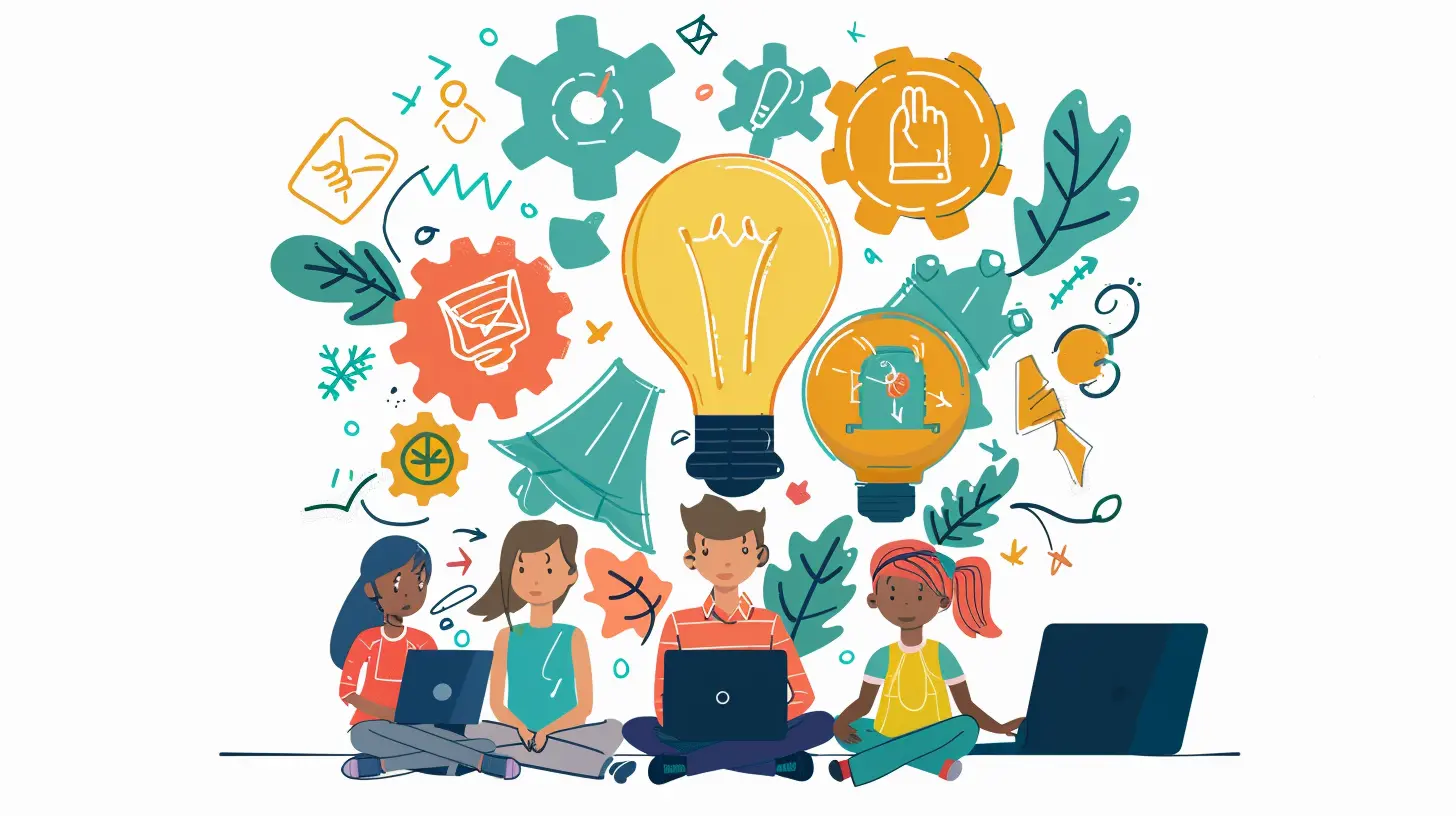20 July 2025
Let’s be real—education often wrestles with the same old problem: how can we teach students to think outside the box while still keeping within the walls of a classroom? Enter coding challenges! In a world run by tech, creativity is no longer just for the arts. Today, even lines of code can paint a masterpiece. And when you bring coding into the classroom with a creative twist, the results can be pretty magical.
If you’re a teacher, parent, or even a curious student, you might be wondering: How can something as technical as coding spark creativity? That’s exactly what we’re diving into.

Why Creativity Matters in Education
Before we get into the nitty-gritty of coding challenges, let’s talk about why creativity even matters in the first place.Creativity helps students:
- Solve problems in unique ways
- Build confidence in their ideas
- Think critically and independently
- Collaborate better with others
Classrooms that foster creativity are environments where students thrive—not just academically, but emotionally and socially. When kids are encouraged to get creative, they become more engaged and excited to learn.
So, how do we inject creativity into a subject like coding, which is often seen as rigid and logical? That’s where coding challenges come in.

What Are Coding Challenges?
Think of a coding challenge as a brain workout—except way more fun and interactive. These are short programming tasks or problems that students solve using logical thinking, creativity, and a splash of tech know-how.But they’re more than just solving problems. Coding challenges:
- Encourage experimentation
- Allow for multiple correct answers
- Promote out-of-the-box thinking
- Turn abstract ideas into tangible projects
Whether it's building a simple game, solving a puzzle, or automating a task, challenges push students to turn imagination into innovation.

The Magic Combo: Creativity + Coding
Here’s a little secret: when students code, they’re not just writing commands for a computer—they’re building their own little worlds.Let’s use an example: Imagine asking your students to build a digital pet using basic code. Sounds fun, right? Now tell them it has to have a personality, favorite food, and a unique reaction when you give it treats. Suddenly, coding becomes storytelling.
This kind of creative coding helps students:
- Think like designers
- Use empathy to create user-friendly interfaces
- Develop storytelling skills
- Blend art and logic in amazing ways
In other words, it’s where art meets science—and the results are epic!

How Coding Challenges Spark Classroom Engagement
You know that glazed-over look students get when they’re bored? Yeah, coding challenges chase that away pretty effectively.Here’s why:
- They're interactive: Students actually do stuff, not just listen passively.
- They’re goal-oriented: There’s a clear outcome, whether it's solving a puzzle or building a prototype.
- They're adaptable: Challenges can be tailored for every age and skill level.
- They're collaborative: Students learn to solve problems together and share solutions.
A classroom full of students coding isn’t silent—it’s buzzing with energy, collaboration, and excitement. And that’s the kind of learning environment we all want, isn’t it?
Real-World Skills, Real Fast
Let’s face it, the world is changing fast. The skills students need today aren’t the same as they were even a decade ago. Coding challenges help develop:- Logical thinking
- Problem-solving skills
- Resilience through trial and error
- Digital literacy
- Teamwork and leadership
But most importantly? They empower students to be creators, not just consumers, of technology.
Simple Coding Challenges That Foster Creativity
You don’t need fancy equipment or a Ph.D. in computer science to get started. You just need a bit of imagination. Here are a few coding challenges you can try in your class today:1. Build Your Own Mini Game
Using platforms like Scratch, students can create their own games. Let them design the characters, narrative, and rules.Why it works:
- Blends storytelling with logic
- Gives students ownership over their creations
- Encourages artistic expression
2. Code a Story
Challenge students to animate or narrate a story using code. They can code their characters to speak, move, or make decisions.Why it works:
- Develops narrative skills
- Merges language arts with technology
- Fuels imagination
3. Design a Digital Escape Room
Students build puzzles and riddles using code for their peers to solve. Think of it as an adventure game with a learning twist.Why it works:
- Boosts problem-solving and creativity
- Promotes teamwork
- Makes learning gamified and fun
4. Random Art Generator
Ask students to write a program that creates unique pieces of digital art each time it runs. Think colors, shapes, and patterns!Why it works:
- Teaches variables and loops
- Encourages artistic exploration
- Shows the beauty of code
5. Create a Classroom Helper Bot
Kids love the idea of robots. Let them code a virtual helper that can, say, answer fun questions or give motivational quotes.Why it works:
- Fosters empathy and functionality
- Challenges logic and interactivity
- Gives a real-world feel to coding
Tips for Encouraging Creativity with Coding
So now the million-dollar question: how do you actually make this happen in your classroom?1. Create a Safe Space for Experimentation
Let students know it’s okay to fail. In fact, encourage “failures” as stepping stones. Coding is all about testing, breaking things, and fixing them again.2. Provide Open-Ended Challenges
Avoid “cookie-cutter” tasks. Instead of saying “Build a calculator,” try “Build a tool that makes your life easier.” Give them a problem, not a blueprint.3. Encourage Collaboration
Pair students up or use group challenges. Let them learn from each other—it builds social skills and multiplies creativity.4. Offer the Right Tools
Use platforms like Scratch, Code.org, or Tynker, especially for beginners. As they grow, transition to Python or JavaScript.5. Showcase Their Work
Let students present their projects. Host a mini “Coder’s Showcase.” When their work is celebrated, they get motivated to keep pushing boundaries.Success Stories: Yes, Coding Challenges Really Work!
Still a bit skeptical? Let’s look at some real-life stories of how coding challenges have made a difference.Case Study: The Sixth Grader Who Built a Weather App
In one school, a sixth-grade student built a weather app using basic HTML and JavaScript during a class coding challenge. He’d always been a bit shy, but after this, he couldn’t wait to show his app to the school principal. This one challenge helped him see himself as a builder—and that confidence spilled over into other areas of learning.Case Study: The All-Girls Coding Club
At a middle school coding club, a coding challenge around building a digital fashion app not only encouraged creative thinking but also brought more girls into the world of tech. Creativity opened the door, and coding offered the keys.Overcoming Challenges in Teaching Coding
Okay, let’s not sugarcoat it. Teaching coding might feel intimidating—especially if you’re not a coder yourself.Here are a few ways to handle that:
- Start small: Even basic block-based coding can go a long way.
- Learn with your students: Be honest—tell them you’re learning too.
- Use online resources and communities: Tons of free tools and lesson plans are out there.
- Collaborate: Reach out to other educators, tech volunteers, or local businesses.
Remember: It’s not about being perfect. It’s about being curious.
The Future of Creativity in Education
As we look ahead, it’s clear that creativity and tech will go hand-in-hand. Coding isn’t just a skill anymore—it’s a language. And just like with any language, the earlier kids learn it, the more fluent they become.By encouraging creativity through coding challenges, we’re not just teaching kids to program. We’re preparing them to shape the future—to design, invent, and dream big.
Final Thoughts
Creativity doesn’t disappear in a swirl of curly brackets and semicolons. In fact, when it comes to coding, creativity thrives.So the next time you hear someone say, “I’m not a creative person,” give them a coding challenge. You’d be surprised at what comes to life when logic meets imagination.
Keep encouraging your students to play with code like it’s a digital Lego set. Let their imaginations run wild. Because when kids are allowed to tinker, build, and break things, something incredible happens—they stop learning by force and start learning by passion.
And honestly, isn’t that what education should be all about?








Camille McCallum
What a fantastic approach to fostering creativity in the classroom! Coding challenges not only enhance problem-solving skills but also empower students to express their unique ideas. Encouraging this blend of creativity and technology will surely inspire the next generation of innovators. Great insights!
November 30, 2025 at 1:58 PM